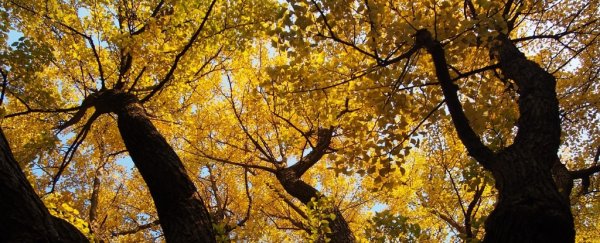The passage of time holds few changes for the Ginkgo biloba tree, commonly known as the maidenhair. For tens of millions of years and through multiple mass extinctions, this "botanical oddity" has stood unwavering, an ever-fixed "living fossil", as the world ages around it.
The species is practically immortal - and that's not an exaggeration. As it turns out, individual trees can live over 1,000 years (some accounts suggest 3,000 even), and now, the most detailed study to date suggests their lifespan is theoretically unlimited.
While ageing and death are a natural part of being alive in this world, some plants like the ginkgo show few signs of growing old.
Even though these trees grow thinner annual rings as the years go on, researchers have found little difference in their ability to photosynthesise, germinate seeds, grow leaves, or resist disease compared to younger trees.
In fact, examining tissue samples from nine ginkgo trees aged up to over 600 years old, the team was unable to find any evidence of senescence, or deterioration, at all.
"In humans, as we age, our immune system begins to start to not be so good," biologist Richard Dixon from the University of North Texas told The New York Times, adding that "the immune system in these trees, even though they're 1,000 years old, looks like that of a 20-year-old."
Unlike previous studies, which have focused mainly on the ginkgo's leaves, the new research hones in on the tree's vascular cambium - a thin layer of tissue in the trunk that produces new bark and wood.
This region contains meristem cells, which are similar to stem cells in animals, although far less researched at a molecular level.
To figure out how the cambrium changes with age, researchers examined each individual's cambrium activity, hormone levels, and resistance-associated genes, as well as transcription factors connected to cell death.
In all the tree ages, they found no significant difference in gene activity or disease resistance. In fact, the only thing that really changed was the width of the tree's rings, which appeared to decrease sharply during the first 100 and 200 years, before continuing at a slower decline over the next few hundred years.
But this doesn't mean all growth was hindered. Interestingly enough, secondary tree growth (measured by the tree's basal area increment, or BAI), did not show any decline from 10- to 600-year-old ginkgo trees.
"Since BAI is a reliable indicator of tree growth," the authors write, "it seems that the vascular cambium in G. biloba can retain the capacity for continuous growth for hundreds of years or even millennia."
It's this feature, they think, that allows the tree to "escape senescence at the whole-plant level".
To be clear, this doesn't mean that ginkgo trees will never die, just that they probably won't die of old age. Instead, ginkgos usually fall from other external factors like wind, fire, lightning, disease, or overlogging, which has, incidentally, brought the species to the brink of extinction in modern times.
"Ageing is not a problem for this species," plant physiologist Sergi Munné-Bosch, who was not involved in the study, told Science. "The most important problem that they have to deal with is stress."
What happens to the ginkgo tree after 600 years of life, however, is still up for debate. There's still a chance this ancient tree species will begin to show signs of molecular ageing in the upper reaches of its lifespan, but the scope of this study was just too small to say.
Further research will be needed before we can know for sure what happens to this special tree over the course of its long, long life.
The study was published in PNAS.
